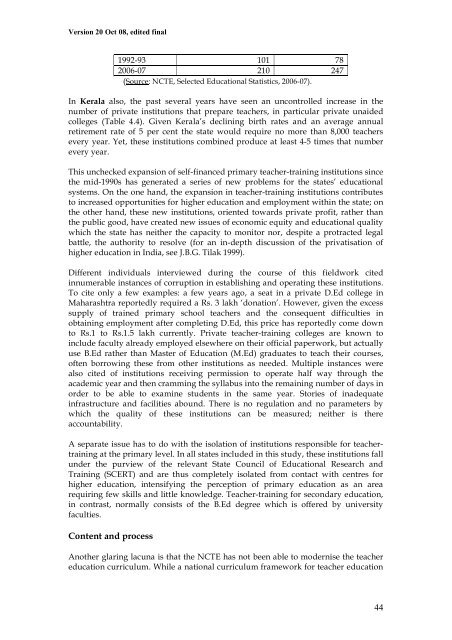primary school teachers the twists and turns of everyday practice
primary school teachers the twists and turns of everyday practice
primary school teachers the twists and turns of everyday practice
Create successful ePaper yourself
Turn your PDF publications into a flip-book with our unique Google optimized e-Paper software.
Version 20 Oct 08, edited final<br />
1992-93 101 78<br />
2006-07 210 247<br />
(Source: NCTE, Selected Educational Statistics, 2006-07).<br />
In Kerala also, <strong>the</strong> past several years have seen an uncontrolled increase in <strong>the</strong><br />
number <strong>of</strong> private institutions that prepare <strong>teachers</strong>, in particular private unaided<br />
colleges (Table 4.4). Given Kerala’s declining birth rates <strong>and</strong> an average annual<br />
retirement rate <strong>of</strong> 5 per cent <strong>the</strong> state would require no more than 8,000 <strong>teachers</strong><br />
every year. Yet, <strong>the</strong>se institutions combined produce at least 4-5 times that number<br />
every year.<br />
This unchecked expansion <strong>of</strong> self-financed <strong>primary</strong> teacher-training institutions since<br />
<strong>the</strong> mid-1990s has generated a series <strong>of</strong> new problems for <strong>the</strong> states’ educational<br />
systems. On <strong>the</strong> one h<strong>and</strong>, <strong>the</strong> expansion in teacher-training institutions contributes<br />
to increased opportunities for higher education <strong>and</strong> employment within <strong>the</strong> state; on<br />
<strong>the</strong> o<strong>the</strong>r h<strong>and</strong>, <strong>the</strong>se new institutions, oriented towards private pr<strong>of</strong>it, ra<strong>the</strong>r than<br />
<strong>the</strong> public good, have created new issues <strong>of</strong> economic equity <strong>and</strong> educational quality<br />
which <strong>the</strong> state has nei<strong>the</strong>r <strong>the</strong> capacity to monitor nor, despite a protracted legal<br />
battle, <strong>the</strong> authority to resolve (for an in-depth discussion <strong>of</strong> <strong>the</strong> privatisation <strong>of</strong><br />
higher education in India, see J.B.G. Tilak 1999).<br />
Different individuals interviewed during <strong>the</strong> course <strong>of</strong> this fieldwork cited<br />
innumerable instances <strong>of</strong> corruption in establishing <strong>and</strong> operating <strong>the</strong>se institutions.<br />
To cite only a few examples: a few years ago, a seat in a private D.Ed college in<br />
Maharashtra reportedly required a Rs. 3 lakh ‘donation’. However, given <strong>the</strong> excess<br />
supply <strong>of</strong> trained <strong>primary</strong> <strong>school</strong> <strong>teachers</strong> <strong>and</strong> <strong>the</strong> consequent difficulties in<br />
obtaining employment after completing D.Ed, this price has reportedly come down<br />
to Rs.1 to Rs.1.5 lakh currently. Private teacher-training colleges are known to<br />
include faculty already employed elsewhere on <strong>the</strong>ir <strong>of</strong>ficial paperwork, but actually<br />
use B.Ed ra<strong>the</strong>r than Master <strong>of</strong> Education (M.Ed) graduates to teach <strong>the</strong>ir courses,<br />
<strong>of</strong>ten borrowing <strong>the</strong>se from o<strong>the</strong>r institutions as needed. Multiple instances were<br />
also cited <strong>of</strong> institutions receiving permission to operate half way through <strong>the</strong><br />
academic year <strong>and</strong> <strong>the</strong>n cramming <strong>the</strong> syllabus into <strong>the</strong> remaining number <strong>of</strong> days in<br />
order to be able to examine students in <strong>the</strong> same year. Stories <strong>of</strong> inadequate<br />
infrastructure <strong>and</strong> facilities abound. There is no regulation <strong>and</strong> no parameters by<br />
which <strong>the</strong> quality <strong>of</strong> <strong>the</strong>se institutions can be measured; nei<strong>the</strong>r is <strong>the</strong>re<br />
accountability.<br />
A separate issue has to do with <strong>the</strong> isolation <strong>of</strong> institutions responsible for teachertraining<br />
at <strong>the</strong> <strong>primary</strong> level. In all states included in this study, <strong>the</strong>se institutions fall<br />
under <strong>the</strong> purview <strong>of</strong> <strong>the</strong> relevant State Council <strong>of</strong> Educational Research <strong>and</strong><br />
Training (SCERT) <strong>and</strong> are thus completely isolated from contact with centres for<br />
higher education, intensifying <strong>the</strong> perception <strong>of</strong> <strong>primary</strong> education as an area<br />
requiring few skills <strong>and</strong> little knowledge. Teacher-training for secondary education,<br />
in contrast, normally consists <strong>of</strong> <strong>the</strong> B.Ed degree which is <strong>of</strong>fered by university<br />
faculties.<br />
Content <strong>and</strong> process<br />
Ano<strong>the</strong>r glaring lacuna is that <strong>the</strong> NCTE has not been able to modernise <strong>the</strong> teacher<br />
education curriculum. While a national curriculum framework for teacher education<br />
44












